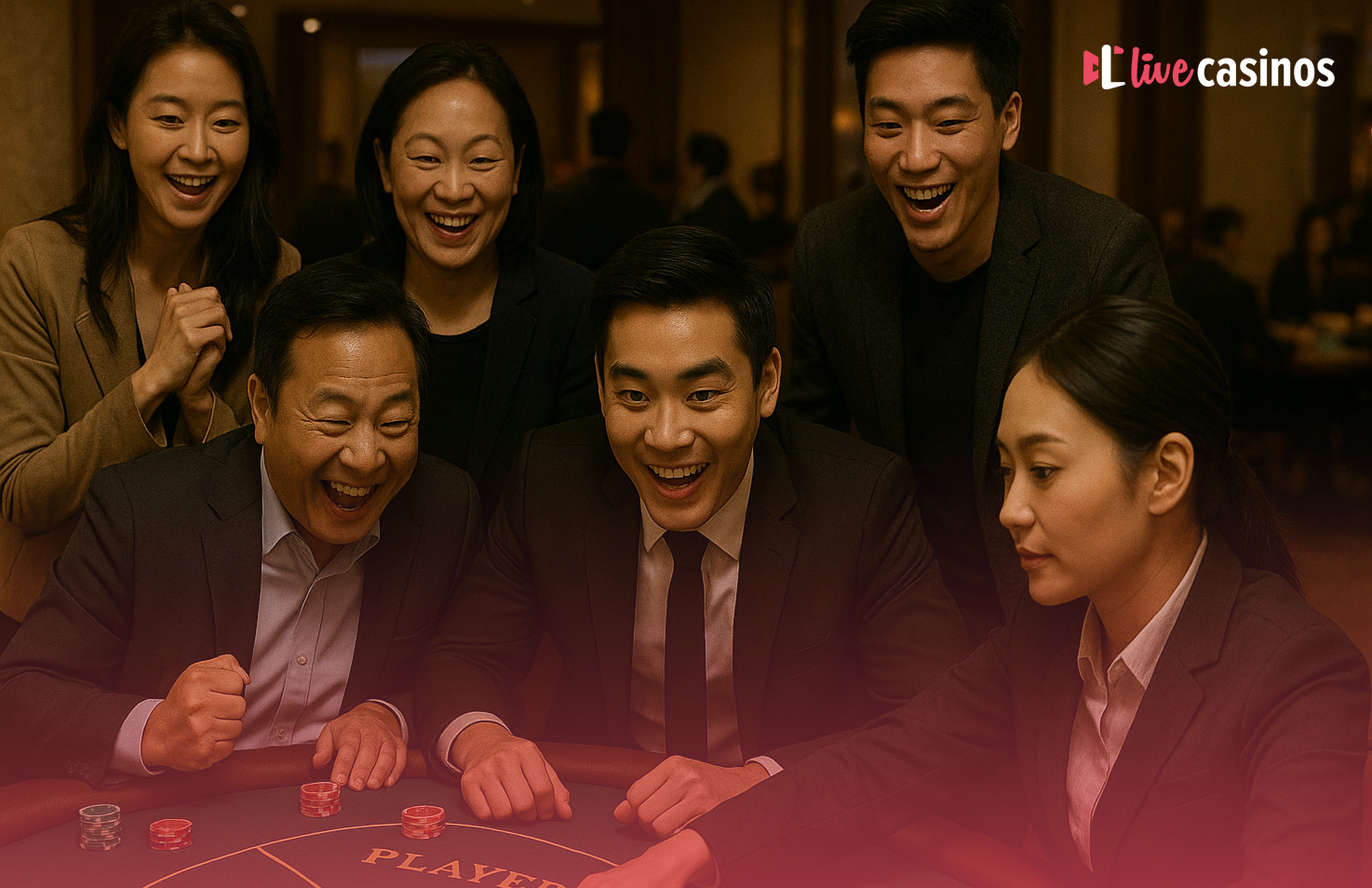We’ll kick things off with a broad look at blackjack and baccarat and the main appeal of these games.
Blackjack
Blackjack is a hugely popular game whose very name is associated with casino gaming. It has a long and storied history which helped it become immensely popular, especially in the West (and specifically the US.)
The main characteristic that sets blackjack apart from many other casino games is the fact that it requires a combination of skill and luck. Where most common betting games are largely based on random chance, knowing the ins and outs of blackjack will actually help you win more in the long run.
This has earned it the reputation of the “thinking player’s” game. If you want to play blackjack and be serious about it, you have to spend time learning the proper plays and strategies. This refers to everything from basic blackjack strategy charts to advanced techniques such as card counting.
As such, playing blackjack is a fairly involved process that takes time and patience. Not only is it harder to learn and master, but its pace is also much slower than baccarat.
Baccarat
Much like blackjack, baccarat is an old card game with a long tradition and a lot of different variants. The original baccarat, whose origins trace back to 18th-century France and Italy, is actually a more traditional card game in which players compete against each other instead of the casino.
The version you’re probably familiar with is actually called punto banco, or sometimes even mini-baccarat.
Either way, the game is characterized by its simplicity, excitement, and fast pace. A typical round of live dealer baccarat lasts under 20 seconds, and most of that time is spent waiting for players to place their bets.
More importantly, baccarat is almost entirely based on luck. A certain level of understanding of the game will help you win a bit more, such as knowing why the Banker bet is typically the best available wager. However, 99% of it comes down to pure chance.
This has led to baccarat becoming incredibly popular with players in Asia, most notably countries such as China, Malaysia, and the Philippines. The gambling culture of many of these countries puts a lot of weight on fate rather than maths, strategies, and statistics. As such, baccarat is perceived as a “true” betting game.
Bill Zender, the former VP of the Aladdin hotel-casino, explained this love for baccarat quite well in a 2012 interview:
“It’s a pure gambling game. Once the cards have been shuffled, cut and placed into the shoe, the cards speak for themselves. Asians have a strong belief in fate.”

Rules & Gameplay
It’s time to get into the real meat of our comparison of blackjack and baccarat – the actual rules and mechanics of these games.
To be clear, this overview is not meant to be an in-depth guide on how to play either blackjack or baccarat. Instead, our goal is to highlight the differences in the process, goals, and experience of playing them. If you’re looking for more comprehensive explanations and beginner-friendly tutorials, check out the guide section of LiveCasinos.
Blackjack
The goal of blackjack is to draw cards from a multi-deck shoe and assemble a hand whose total value is as close to 21 as possible without going over. To win, a player’s hand has to be closer to 21 than the dealer’s.
At the start of every round, every player is dealt exactly 2 cards. The dealer also receives 2 cards, but only one of them is visible to the players.
Players then take turns making important decisions about how they want to progress. In most variants of the game, you have four possible options – Hit, Stand, Double, or Split.
- Hitting means you wish to draw another card from the deck, hopefully getting you closer to 21.
- Standing means that you are happy with the current total and you don’t want any additional cards. This option effectively ends your current turn.
- Doubling allows you to increase the stake twice over, after which you’re forced to draw one additional card and then Stand.
- Splitting allows you to turn two cards of the same rank into two separate hands.
Importantly, card values in blackjack are typically based on their rank. While most cards have their face value (the number printed on the card itself), Jacks, Queens, and Kings all count as 10. Aces can count as both 1 and 11, depending on which is preferable to the current hand.
After all players either Stand or Bust (go over 21), the dealer may also draw additional cards. Typically, dealers only draw up to 17, after which they’re forced to Stand.
After the whole process is complete, the dealer’s hand is compared to the player’s. If the player’s hand is closer to 21 than the dealer’s, they win a 1:1 payout. Both sides can also win instantly by drawing exactly 21 with only two cards, which is called a Natural hand or simply Blackjack. On top of winning immediately, such hands pay better (usually 3:2).
There is only only one bet in the main game of blackjack – you either participate or don’t. However, many tables (especially live dealer versions) also offer a number of blackjack side bets.
That sums up most of the basics. If you’re looking for a more detailed explanation, refer to our blackjack tutorial.
Baccarat
Baccarat is generally a much more beginner-friendly game than blackjack. Players don’t have to make nearly as many decisions, and the ruleset is easier to pick up and master. Moreover, it’s much more forgiving because not knowing the ins and outs of baccarat won’t really hurt your chances of winning.
The goal of baccarat is to predict which of two card piles – Player or Banker – will draw cards whose total value adds up to as close to 9 as possible. Each of these piles receives two or three cards based on specific rules, after which the cards’ values are summed up and compared to each other.
Card values in baccarat are calculated based on a few rules:
- Only the last digit of a hand total is used as the hand’s value. For example, a total hand value of 13 counts as a 3
- Cards 2-9 all have their face value
- Aces always count as 1
- Cards 10+ all count as 10, which effectively counts as 0
Whichever pile ends the round with a score closer to 9 wins. All players who made the corresponding bet receive a 1:1 payout, though Banker bets are often subject to a 5% fee. Alternatively, you can bet on a Tie, which wins 8:1 if both piles end up with the same hand total.
That’s pretty much all you need to know about baccarat to play and enjoy the game. However, it’s worth noting that the game’s simple premise resulted in all sorts of variations, side bets, and extra features. However, all of them are based on the straightforward rules we just described.
Payouts
Both blackjack and baccarat have a straightforward payout structure because both games essentially only have two or three possible outcomes.
Generally speaking, the main bets of both blackjack and baccarat pay even money, which is a 1:1 payout. However, both also feature circumstances in which players can win more.
In blackjack, winning with a Natural hand (drawing an Ace and a 10-value card as your first two cards) results in a 3:2 payout. Players can also increase their relative returns by using the Split and Double options. Additionally, if you end your turn with the same hand value as the dealer, your full stake is returned to you.
In baccarat, both the Player and Banker bets pay 1:1. However, the Banker bet is always slightly more likely to win than the Player, which is why the classic version of the game features a 5% fee on all Banker bet payouts. This effectively means that you’ll win 0.95:1.
The Tie bet is substantially more profitable with most tables paying 8:1. However, the Tie bet is generally considered a poor option due to its low RTP.
It’s worth noting that these payouts unfortunately do not always follow this exact standard. Some versions of these games may offer different rates for specific outcomes. For example, certain blackjack tables infamously pay 5:6 for blackjack while some baccarat versions remove the 5% commission on Banker bets.
Either way, we recommend checking the exact payouts offered by a specific table before putting down any real money.
RTP & House Edge
Both of these casino card games are highly valued for their exceptionally low house advantage. However, the Return-to-Player rates of these two games reveal some of their most important differences as well.
On one hand, blackjack is likely the best casino game out there in terms of RTP. Although the exact percentage can vary depending on the game variant and table rules, it tends to be somewhere in the range of 99 – 99.5%. This is by far the lowest house edge you’re likely to find if you’re playing against a casino.
However, the expected value of blackjack bets heavily depends on how you play the game. In other words, if you’re making the wrong decisions and are not following proper blackjack strategy, the effective RTP of your wager can be much, much lower.
This is one more way in which the player’s skill can heavily influence their experience, winnings, and even profits while playing blackjack.
On the other hand, the RTP of baccarat is different for each of its main bets. Assuming the table uses the exact rules we described above, the RTP of baccarat bets is as follows:
- Player bet – 98.76%
- Banker bet – 98.94%
- Tie bet – 85.6%
As you can see, the Player bet in classic baccarat is statistically the best option. Conversely, these figures clearly illustrate why the Tie bet should be avoided in most situations.
Unlike blackjack, however, Baccarat always offers the exact same RTP, no matter what you do as a player. Every time you make a Player bet, you’ll get an average return of 98.76%, regardless of the round’s outcome or other circumstances. This fact is one of the crucial factors that ultimately makes baccarat a much more accessible game.
It’s also worth noting that 98.94% is still exceptionally high by casino game standards. Although blackjack is theoretically the better option, baccarat can be considered a close second when compared to games like roulette, casino poker, or even slots.
Blackjack vs Baccarat: Statistics
Every bet in gambling is defined by two important factors: how much it pays and how likely it is to win. The ratio of these two figures also defines its RTP, which pretty much tells you whether it’s a good bet or not.
We’ve already covered the payouts and RTP, so we should take a look at the probabilities of different bets as well. We’ll sum up everything in a single table, giving you easy insight into the maths beneath these popular card games.
Blackjack
Below are the most important figures when it comes to blackjack odds and statistics. Note that these odds are calculated assuming standard rules (as described above), a fresh card shoe, and a completely new round in which no cards have been revealed yet.
- The probability of players winning a round of blackjack is around 42%.
- Dealers win just under 49% of all hands, while the remaining 9% of rounds result in a Push.
- The probability of winning with a natural Blackjack is 4.8%. The dealer’s chances of hitting a natural 21 are roughly the same.
Baccarat
Baccarat odds are a lot easier to calculate. Assuming a fresh card shoe, every type of bet enjoys a consistent chance to win.
- Player bets win 44.6% of all baccarat rounds.
- Banker bets win 45.8% of the time thanks to favorable third-card rules
- The remaining 9.6% of rounds result in a Tie
Although the difference between Player and Banker bet odds seems negligible, it allows Banker bets to be statistically slightly superior despite having a 5% commission on payouts.
We’ll sum up the odds and statistics of Blackjack and Baccarat in the table below.
Common Strategies
As we’ve already mentioned before, blackjack and baccarat have some similarities and a lot of differences. More importantly, these differences affect how players approach these games and how they play them. As a result, strategies for blackjack and baccarat are very different in many ways.
We’ll go through the core principles of blackjack and baccarat strategy below, which should illustrate the fundamental differences between how these games are played.
Blackjack
Due to its high skill ceiling, blackjack is likely one of the most discussed casino games when it comes to strategy.
For starters, the decisions players make can make all the difference in the world. You win and lose based on your choices, which is what appeals to many blackjack fans in the first place. Moreover, blackjack is one of the very few betting games in which players can beat the casinos: card counting is a proven method of successful advantage play. That said, the game has evolved in such a way that beating the casinos is not really viable for most people.
The most essential question of blackjack strategy is quite simple: what should the player do in a given situation? What is the “right move” that maximizes your chances of winning and your profits?
The answer to this question is surprisingly straightforward because it was cracked by mathematicians and advantage players a long time ago. Every possible scenario you can find yourself in while playing blackjack has a “correct” answer – the move that is most likely to result in you winning.
The sum of these answers is called basic blackjack strategy. Basic strategy is essentially a table that tells you what you should do based on your current hand total and the dealer’s visible card. That’s why it’s often simply called a “blackjack chart”.
These days, the most important chart to remember is the 4-8 deck blackjack strategy. It’s what you should use while playing most modern versions of the game, including the majority of live dealer variants.
While essential, basic blackjack strategy is also exactly that: basic. Learning these charts and following their instructions does not mean you’ve mastered the game. They’re the bare essentials that you should learn as a starting point.
Beyond that, blackjack is also home to one of the most infamous techniques in gambling: card counting. Blackjack card counting is an advanced strategy that allows players to leverage advantageous card shoes to gain an advantage over the casino. Unlike most systems and tactics players like to use while gambling, this strategy is backed by actual maths. However, it’s also next to impossible to pull off these days thanks to countermeasures employed by the casinos.
To sum up, playing blackjack gives players a lot of power to control their fate (relative to other casino games.) As a result, its strategies are quite involved, sometimes complicated, and take a bit of number-crunching to truly understand. That’s why the game is most enjoyed by patient, strategically-minded players who don’t mind devoting time and effort to being successful in gambling.
Baccarat
As we’ve already established by now, baccarat is much more based on luck than blackjack. As a player, the results of every round don’t really depend on you or anything you do. It’s mostly the luck of the draw.
That said, there are still ways to optimize your baccarat strategy and ensure you’re getting the best returns possible. These common baccarat strategies can be summed up in a few simple points:
- Bet on the Banker – The RTP of the Banker bet is slightly better than the Player and substantially better than the Tie. If you want to minimize the casino’s advantage, the easiest way to do so is to simply never bet on anything else.
- Avoid Tie bets – The Tie bet in baccarat is the complete opposite to the Banker since it’s statistically the worst wager you can make.
- Use Side Bets sparingly – Most baccarat side bets offer a substantially lower RTP rate than the classic Player/Banker dilemma, and it’s often best to avoid them completely. That said, some variants of baccarat do offer worthwhile side wagers. It’s a good idea to carefully read the rules, payouts, and RTP rates for every bet available at any table you’re playing on.
- Manage your bankroll – Money management is an essential skill for every punter. However, it’s especially important for fast-paced games like baccarat because you’ll likely play through a lot of rounds very quickly. An unlucky streak can quickly drain your bankroll if you’re not careful.
- Avoid the Gambler’s Fallacy – Many players believe that sometimes, certain results in baccarat are “due” or that long streaks of identical outcomes never happen. In truth, the results of previous rounds do not affect future rounds in any meaningful way. Don’t put too much stock in roadmaps, patterns, trends, or hot and cold numbers.









































 Roulette
Roulette
 Blackjack
Blackjack
 Baccarat
Baccarat
 Poker
Poker
 Sic Bo
Sic Bo
 Dragon Tiger
Dragon Tiger
 Game Shows
Game Shows  Top 5 Games
Top 5 Games  See more
See more  Roulette Casinos
Roulette Casinos  Low Limit
Low Limit  High Limit / VIP
High Limit / VIP  Exclusive
Exclusive  How to Play
How to Play  Basic Strategy
Basic Strategy  Top Tips
Top Tips  FAQ
FAQ  Blackjack Casinos
Blackjack Casinos  Baccarat Casinos
Baccarat Casinos  Bonuses
Bonuses  Poker Casinos
Poker Casinos  Game Providers
Game Providers  Sic Bo Casinos
Sic Bo Casinos  Dragon Tiger Casinos
Dragon Tiger Casinos  Credit and Debit Card
Credit and Debit Card  e-Wallet
e-Wallet  Cryptocurrency
Cryptocurrency  Bank and Checks
Bank and Checks  Pay by Phone and SMS
Pay by Phone and SMS  See more
See more  How-To Guides
How-To Guides  Top Lists
Top Lists  In-Depth
In-Depth  Strategy
Strategy  Casino & Games
Casino & Games  Insight
Insight  News
News  Promotions
Promotions 
 Guide to Live Casinos
Guide to Live Casinos  Top 10 Live Casino Tips
Top 10 Live Casino Tips  Studio Locations
Studio Locations  FAQ & Help
FAQ & Help  Meet The Dealers
Meet The Dealers  Our Awards
Our Awards  How We Rate
How We Rate  Responsible Gambling
Responsible Gambling 




























 ENG
ENG 







 Facebook
Facebook
 Pinterest
Pinterest
 Twitter
Twitter
 LinkedIn
LinkedIn
 Copy Link
Copy Link 




















